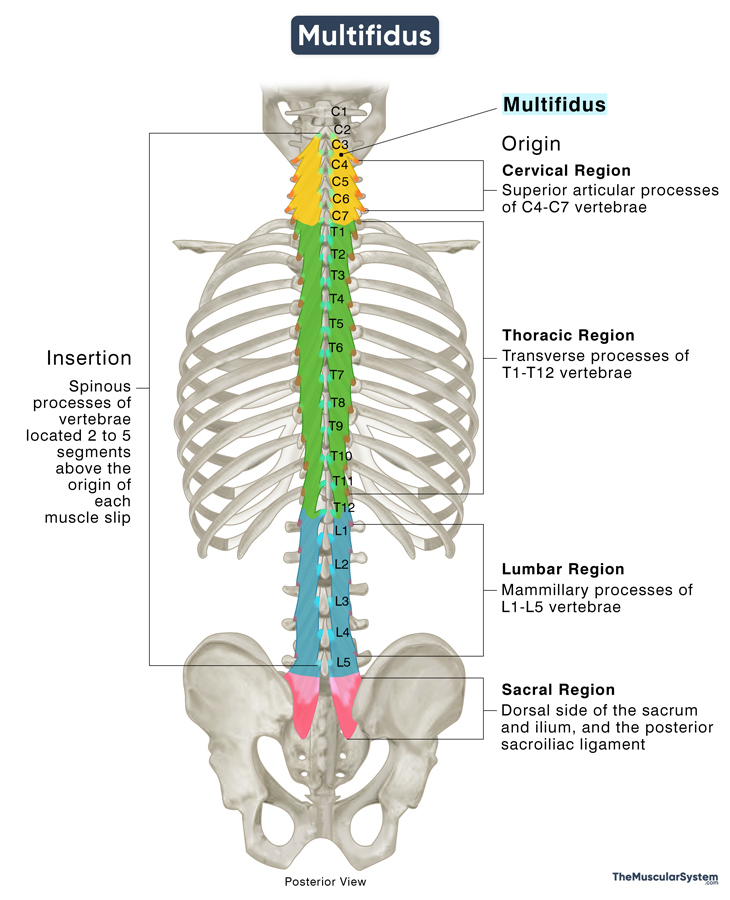Multifidus
Last updated:
30/10/2024Della Barnes, an MS Anatomy graduate, blends medical research with accessible writing, simplifying complex anatomy for a better understanding and appreciation of human anatomy.
What is the Multifidus
The multifidus is a group of short, fleshy muscles spanning the entire spinal cord, located on either side of the cervical to lumbar vertebrae. Their primary function is to stabilize the vertebral joints and the spinal cord.
These short muscles belong to the transversospinales muscle group, forming the deep layer of the intrinsic back muscles.
Anatomy
Location and Attachments
| Origin | Superior articular processes of C4 to C7 vertebrae, transverse processes of all thoracic vertebrae, mammillary processes of all lumbar vertebrae, the dorsal side of the sacrum and ilium, and the posterior sacroiliac ligament |
| Insertion | The spinous processes of vertebrae located 2 to 5 vertebral segments above the origin of each muscular strip or fascicle |
Origin
The muscle is divided into 4 regions based on the location of the spine from which the short triangular muscular strips originate:
- Cervical Region (Multifidus Cervicis/colli): From the superior articular processes of the 4 lowest cervical vertebrae (C4-C7).
- Thoracic Region (Multifidus Thoracis): From the transverse processes of all the 12 thoracic vertebrae
- Lumbar Region (Multifidus Lumborum): From the mamillary processes of all 5 lumbar vertebrae
- Sacral Region: From the posterior aspect of the sacrum bone, just beside the posterior foramina, and the medial aspect of the posterior superior iliac spine (PSIS). The origin of this part also extends to the posterior sacroiliac ligaments and the aponeurosis from which the erector spinae muscles arise.
Insertion
The muscular strips then extend obliquely upward and toward the midline to insert into the top of the spinous processes of the vertebrae located 2 to 5 levels higher than the point of origin. The longer strips often insert 4 to 5 levels higher, while the shorter strips may travel 2 to 5 levels before reaching their insertion point. For example, in the cervical region, the fascicles travel upward to insert into the spinous processes of the 2nd to 5th cervical vertebrae (C2-C5).
Relations With Surrounding Muscles and Structures
The small muscles fill the groove on both sides of a vertebra, between the transverse and spinous processes, from the 1st cervical vertebra or axis down to the 5th lumbar vertebra and sacrum.
As part of the transversospinalis group, the multifidus contributes to the third deepest layer of the intrinsic or deep muscles of the back. Of the other two transversospinalis muscles, the rotatores lie directly beneath it, while on the superficial side, the multifidus is positioned alongside the semispinalis cervicis and semispinalis thoracis.
The muscle is also located beneath the erector spinae group, which includes the spinalis, longissimus, and iliocostalis muscles, as well as the internal and external obliques of the abdomen. The levatores costarum (brevis and longus) muscles lie laterally, while the interspinales are located medially to the multifidus.
Function
| Action | Stabilizing the spine, as well as extending, laterally flexing, and rotating it |
Role in Stabilizing the Spine
As each segment of the multifidus muscle spans 3 to 4 consecutive vertebrae and fills the spaces between the transverse and spinous processes, its primary role is to stabilize the vertebral joints. The muscle is crucial in maintaining both stiffness (for stability) and flexibility (allowing controlled movement), as it supports spinal alignment and controls the small, precise vertebral movements. As a result, it helps reduce excessive wear and tear on these joints, lowering the risk of degeneration.
Role in Moving the Spine
When both sides of the multifidus muscle contract at the same time (bilateral contraction), it extends the vertebral column, allowing you to straighten your back as you would when standing upright.
When the muscle contract on only one side (unilateral contraction), it helps flex the spine laterally towards the same side as the contracting muscle, which lets you bend the body trunk sideways. Additionally, this action of the muscle aids in rotating the spine and body trunk to the opposite side of the contracting muscle – this happens due to the oblique orientation of the muscle.
Innervation
| Nerve | Dorsal rami of spinal nerves |
Each muscular fascicle of the multifidus is innervated by the medial branches of the dorsal (or posterior) rami of the corresponding cervical, thoracic, and lumbar spinal nerves.
Blood Supply
| Artery | Deep cervical, occipital, vertebral, posterior intercostal, subcostal, lumbar, and lateral sacral arteries |
The muscle has various arteries supplying to the different regions:
- The cervical region receives vasculature from the deep cervical, vertebral, and occipital arteries.
- The thoracic region receives blood supply from the subcostal arteries and the dorsal branches of the posterior intercostal arteries.
- The lumbar region has the lumbar and lateral sacral arteries supplying it.
- The sacral region also receives vasculature from the lateral sacral arteries.
References
- Multifidus Muscle: GetBodySmart.com
- Multifidus Muscle | Origin, Insertion & Action: Study.com
- Multifidus Muscle: Kenhub.com
- Multifidus: TeachMeAnatomy.info
- Multifidus Muscles: Elsevier.com
- Multifidus: HealthLine.com
Della Barnes, an MS Anatomy graduate, blends medical research with accessible writing, simplifying complex anatomy for a better understanding and appreciation of human anatomy.
- Latest Posts by Della Barnes, MS Anatomy
-
Inferior Pharyngeal Constrictor
- -
Middle Pharyngeal Constrictor
- -
Superior Pharyngeal Constrictor
- All Posts






